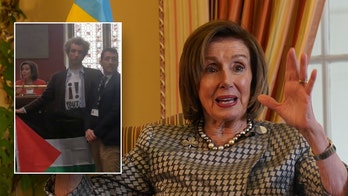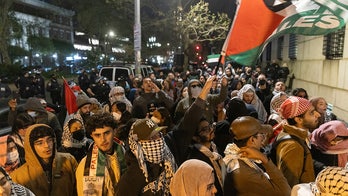
In this Oct. 24, 2003, file photo, Palestinian masked Hamas terrorists march during a protest rally at Jabaliya refugee camp in the Gaza Strip. (AP)
An appeals court ruling allows a case to proceed against the Palestinian Authority by the family of a contractor killed by a roadside bomb while providing security to State Department employees during an October 2003 trip to the Gaza Strip.
On Friday, the three-judge panel, members of the U.S. Court of Appeals for the District of Columbia, released a ruling explaining that the family of Mark Parsons can sue the Palestinian Authority under the Anti-Terrorism Act of 1991 over questions of material support by the PA to a terror group. The decision overturns part of a lower court's summary judgment in favor of the PA.
"Although we agree with the district court that the family's conspiracy claim theories are too speculative to survive summary judgment, we believe a reasonable juror could conclude that Palestinian Authority employees provided material support to the bomber," reads the ruling.
Mark Parsons and two other members of DynCorp International were killed by a roadside bomb while protecting a convoy that included State Department employees on their way to interview Palestinian Fulbright Scholarship applicants. A roadside bomb exploded as the convoy traveled past the Jabaliya refugee camp in the Gaza Strip, about a quarter of a city block away from a manned PA security checkpoint.
The PA, U.S. and Israeli officials all conducted investigations into the bombing. Documents provided to the Parsons family and included in the suit showed that the PA detained six suspects, including Amer Qarmout, a leader of the Popular Resistance Committee, who admitted that he had dug a hole in that spot to place a bomb and asked guards with the PA National Security Service to ignore the shoveling, which he said they did. However, Qarmout said he never personally planted a bomb.
According to the Investigative Project on Terrorism, which tracks data on "radical Islamic terror groups," the immediate forensics investigation after the bombing reportedly was cut short when Palestinians made their way to the explosion site and started tampering with the scene. According to documents released by the FBI, investigators had stones thrown at their cars as they were leaving the area.
The lower court threw out the Parsons family claim under the Anti-Terrorism Act because it said the family cannot link the PA to a specific bomber. But the appeals court ruled that sufficient evidence existed, including forensic reports that showed the bomb that killed Parsons was made of the same material Qarmont says he uses for bomb-making.
That and other statements and documents are enough to allow the case to go to a jury, the judges ruled.
"Sorting out these contradictions, deciding how much weight to give evidence that supports or undermines the family's case and evaluating how much credibility to assign Qarmout's incriminating versus exculpatory statements are prototypical jury functions that courts may not commandeer," the court ruled.
"In sum, we conclude that a reasonable juror could find on the basis of the family's evidence that Qarmout planted the bomb that killed Parsons and that Palestinian Security forces at the nearby security checkpoint complied with Qarmout's request not to interfere with his effort to plant a bomb," the ruling reads. "Because such acts qualify as providing material support ... we reverse the district court's grant of summary judgment to the Palestinian Authority on the family's material support claim."
The circuit court judges -- Karen LeCraft Henderson, David S. Tatel and Janice Rogers Brown -- were split on several questions posed by the appeal, and reaffirmed the lower court's decision siding for the PA on whether a conspiracy was in the works to target U.S. security personnel.
Though the State Department mentioned the three men who were killed in its 2004 annual report on Patterns of Global Terrorism, IPT said infighting between the FBI and State Department had hampered the investigation.
IPT reported that John Parsons, the brother of Mark Parsons, said he was told in October 2010 that the FBI had closed the case on the deaths of Parsons as well as John Branchizio and John M. Linde Jr., although no perpetrator was ever caught.




